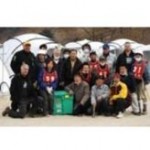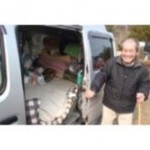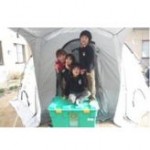ShelterBox
Wednesday 20 April 2011 – Hope for the future as Japan rises to her feet
There is a strong sense of hope for the future in Japan, according the ShelterBox Response Team (SRT) operating in the country.
It is now nearly six weeks since the earthquake and tsunami destroyed swathes of Japan’s coastline. A huge clean up operation has been underway since the disaster struck and the Japanese authorities are making strong progress as Japan rises back to her feet.

A girl in front of her tent in Inwanua, Miyagi Prefecture. Photograph: Thomas Lay
‘The country and the people are doing a phenomenal job of recovering,’ says SRT member Tom Lay (UK). ‘The progress of the clean up operation is creating a massive psychological and emotional benefit. There’s very much a feeling of Japan standing back up after a knockout blow and still fighting.
‘There’s definitely a sense of moving on from the people who have been affected by the disaster and they have hope as they move forward and look to the future.’

A gentleman in his ShelterBox tent in Yamamoto in the Miyagi Prefecture of Northern Japan. He lost his home in the tsunami. Photograph: Thomas Lay
The cherry blossom in Japan’s north is starting to bloom, a sign the weather is beginning to turn and the cold weather is coming to an end, a key factor as families begin to leave crowded evacuation centres. ShelterBox continues to work throughout the coastal areas affected, helping families affected by the disaster as they begin to rebuild their lives.
Tom Lay added: ‘The support we’re currently receiving from Rotarians in Japan is invaluable and they’ve been crucial in helping us operate in the areas we’re working in.’
Since the earthquake people around the world have been supporting ShelterBox’s work in a huge range of exciting ways. There has been something for everyone to get involved with, from an auction by iconic rock band Sonic Youth to a Twitter fundraising drive by author Maureen Johnson.
 One of the latest fundraising drives for ShelterBox’s global disaster relief efforts is called ‘Songs of Love For Japan’ which is a three-day flash sale of 100 tracks of rare and inspiring music. Artists supporting the project include Tori Amos, Ani DiFranco, Wolf Parade, The XX, The Submarines and Josh Ritter.
One of the latest fundraising drives for ShelterBox’s global disaster relief efforts is called ‘Songs of Love For Japan’ which is a three-day flash sale of 100 tracks of rare and inspiring music. Artists supporting the project include Tori Amos, Ani DiFranco, Wolf Parade, The XX, The Submarines and Josh Ritter.
The flash sale ends on Thursday, April 21 with all proceeds going to ShelterBox. To find out more or purchase the tracks visit www.solfj.org.
The families ShelterBox are helping in Japan have expressed their amazement at the generosity donors around the world have shown towards them during their time of need.
Tuesday 05 April 2011-’Arigato ShelterBox’ from families in Japan.
ShelterBox Response Teams (SRTs) continue to work along the affected areas of Japan’s north east coast. They are delivering emergency shelter and lifesaving supplies to families who lost all they had when the tsunami struck.
In Yamamoto, a town near Sendai, SRT members Ian Neal (UK) and Mark Dyer (US) found 30 families living in cars outside an evacuation centre. The families’ homes were destroyed when the tsunami hit and they have been living in their cars ever since.
ShelterBoxes have now been delivered to all 30 families as they attempt to rebuild their lives.
One of the people to move into a ShelterBox tent was Toshi Iche Iwasa, an 80 year old man who had been living with two of his family members in the back of his vehicle after losing his home in the tsunami.
When the earthquake and tsunami struck, he was picking strawberries at a small family farm. He said the earthquake was so strong it is difficult to describe. Everything began to shake and he took cover on the ground. When he tried to pick himself up he couldn’t and his wife was only able to crawl across the floor towards him. In the 80 years of his life he has experienced many earthquakes but nothing like this one.
As soon as he heard the tsunami warning he and his wife headed straight to his car and drove for higher ground. They never expected to the tsunami to be the size and scale that it was. His home was completely destroyed; crushed by debris in the wave with the scattered pieces being swept out to sea.
Mr Iwasa added he was lucky because his children and two grandchildren made it to higher ground but their homes were also destroyed. Since that time, they have all been living in their vehicles. Now, Mr Iwasa and eight of his relatives are living in a ShelterBox tent.
SRT member Mark Dyer (US) said: ‘It was great to move Mr Iwasa and his family into one of our tents. He was so excited to talk to his family and let them know they could start living together.
‘He was amazed that donors from all over the world work with ShelterBox to bring this type of lifesaving equipment to people who lose everything in a disaster. He just kept saying Arigato (thank you) ShelterBox.’
SRT members have also been working further north in the Iwate Prefecture. Pictured above are Yukie Shozushima, aged 25, and her children, Kiichi, aged 6, Koki, aged 4, and Shunta, aged 1, from the town of Kamaishi. At the time of the picture being taken their father was helping other men from the town who were attempting to clear up the debris from the tsunami.
Kamaishi is another town which has been completely destroyed by the tsunami. Yukie Shozushima was at home with her husband when the tsunami siren sounded.
‘They told us they immediately rounded up their children and as they went outside they heard, and then saw, the tsunami coming,’ said SRT member Pat Prendergast (UK).
‘They said the houses in front of theirs were being demolished so they ran like the wind with the tsunami at their back until they reached higher ground. They lost everything like so many other families.
‘One of the things that has upset them the most is they’ve lost a home full of memories. They said they are so grateful for ShelterBox for providing them a home where their family can live together safely.’
ShelterBox Responds To Need for Shelters To Replace Evacuation Centres Based In Schools Before April School Year Starts
April 1, 2011 – It is now three weeks since the 9.0 magnitude earthquake hit Japan, triggering a tsunami that claimed thousands of lives, destroyed hundreds of thousands of homes and wiped out swathes of Japan’s north east coast.
ShelterBox arrived on the ground less than 24 hours after the earthquake struck and more than 1,500 ShelterBoxes have now been committed to the people of Japan as they begin to rebuild their lives. This aid is being sent into the country based on official request being made to ShelterBox from the Japanese authorities.
ShelterBox Response Teams (SRTs) have been working closely with the Japanese authorities and Rotary districts in the Iwate, Miyagi and Fukushima Prefectures. ShelterBoxes are being distributed throughout these Prefectures to families who lost everything in the tsunami.
In the town of Ofunato, in the Iwate Prefecture, families have expressed their gratitude for the help ShelterBox is giving them.
17 year-old, Kinno Masako said: ‘Before the wave came my family used to live in a house by the shore. I was in my school when the warning came and my mother was at work.
‘The first night I had no choice but to stay at the school with my mother and everyone else. When we found out the wave had taken our house we knew had nowhere to stay. Our house, and everything in it, is gone, it was right by the shore.
‘We were staying with lots of other families but now we have been lucky to be given a ShelterBox tent so we have a place to stay together.’
1,574 ShelterBoxes have now been committed to Japan and thousands more remain on standby should they be required. Alongside this, more than 10,000 of ShelterBox’s winter gloves, scarves and hats are being sent to Japan as the freezing conditions continue.
John Diksa added: ‘Families have been living in our tents for well over a week now and we’re certainly seeing life being rekindled. In the evacuation centres, where we’ve been helping the families living there, there is a fantastic sense of community with people of all ages helping each other and pulling together.’
The need for shelters to replace the evacuation centres currently in use is becoming greater as many of these centres are schools. The authorities need these schools to be empty in time for the start of the academic year which begins in April.
SRT members from France, USA, Canada, New Zealand and the UK are all currently working in the country.
Japanese authorities express ‘deepest respect’ for ShelterBox’s work
March 28, 2011 – Lifesaving aid from ShelterBox is helping families in Japan as they begin to rebuild their lives after the earthquake and tsunami that hit the country on March 11.
The charity’s work is being welcomed by officials in Japan’s Prefectural government system who say ShelterBoxes will be used to provide emergency assistance to the most vulnerable.
Takanori Hirai, Director of the Climate Change and Energy Policy Division for the Iwate Prefectural Government said: ‘We thank you from the bottom of our hearts for your kind donation of ShelterBoxes after Japan’s horrible earthquake and tsunami disaster.
‘These ShelterBoxes will be used in a variety of ways; as shelters in the affected areas, protecting the privacy of those living in shelters and creating a space for families to live in.
‘We have the deepest respect for the efforts that ShelterBox is carrying out throughout the world. We hope that your organisation will grow even larger in the future.’
ShelterBox tents have been used to provide privacy and restore dignity to families sheltering in an evacuation centre – a school gymnasium – in Ofunato, a coastal town which was devastated by the tsunami.
One of the families to receive a ShelterBox tent were Rah (father), Rie Hatakeyama (mother), Kahoh (9-year old son) and 11 month old Yasushi.
Speaking to ShelterBox Field Operations Specialist Mark Pearson (UK), Rah said: ‘My house disappeared in the tsunami. Since the tent arrived it has made things much better for us, at the evacuation centre privacy is important to us.
‘When the tsunami came I was outside my home. We saw smoke and we ran away to higher ground. Everyone is helping each other at the evacuation centre and we hope Ofunato will recover in the future.’
Sense of dignity
200 tsunami survivors, a mixture of young families and elderly people, are sheltering in the school gymnasium.
Mark Pearson added: ‘It’s snowing heavily on a regular basis here and there’s very limited kerosene to fuel the heaters inside. Our tents are being used by young families as a private space and a sleeping area. This is incredibly important for morale and is giving the families back a sense of dignity.
‘Also these evacuation centres are open places to anyone and the tents add a sense of security for people’s belongings.’
The Japanese government has said that 8,800 temporary housing units will be built in the Iwate Prefecture. In Ofunato 1,400 are being built and it is expected to take between three to four months for them to be completed.
According to OCHA (United Nations Office for the Coordination of Humanitarian Affairs) more than 27,500 people have been confirmed dead or remain unaccounted for.
A survey found that of this number more than 60% were over the age of 60 – meaning the elderly were the worst affected by this disaster. This saddening statistic means that the elderly were probably not able to evacuate quickly enough despite the tsunami warnings.
Families grateful for ShelterBox Solution in Japan
March 24, 2011 – Earlier today ShelterBox tents were set up for families in desperate need in the tsunami-hit Iwate Prefecture of Japan.
The ShelterBox Response Team (SRT) have been working with the local authorities to bring emergency shelter to families who lost their homes in the tsunami.
Hashimoto-san, a local politician from the Iwate Prefecture who has lent his expertise and local network to help ShelterBox’s efforts in the country, said: ‘It’ll be up to three months before temporary housing can be made available to those displaced by the tsunami.
‘Many individuals who have been forced to choose between crowded displacement centres or dependence on the hospitality of friends and neighbours will prefer the independence and privacy afforded by the ShelterBox solution.
‘We hope ShelterBox can support us with the quantities required in a timely fashion to make this possible. The displaced were concerned about the long wait ahead before the completion of government temporary housing and are relieved and grateful for the solution ShelterBox has provided.
‘In this season freezing winds blow across the coastlines and the opportunity to remain near their homes yet avoid discomfort is being gratefully seized by the affected families.’
‘It’s the most complex disaster scenario I ever had to deal with and this includes the Indian Ocean tsunami and the Haiti earthquake,’ said ShelterBox Field Operations Specialist Mark Pearson. ‘As we continue to assess the affected areas we found 60 people living in their cars who now all want a ShelterBox tent.
‘A request has been made and now those who want a ShelterBox can collect them from our shared warehouse owned by Rotarian Tamura-san. Tamura-san chose to fill the gap left by major aid and governmental agencies by collecting supplies from his business and personal networks around the country and distributing directly to smaller displacement centres and overlooked communities.’
The team are currently based in Morioka in the Iwate Prefecture working with Rotarians and the local authorities. In the coming days they also plan to be working with Rotary clubs in and around Sendai to bring emergency supplies to families in the Miyagi Prefecture who lost everything in the tsunami.
ShelterBox is an international disaster relief charity that delivers emergency shelter, warmth and dignity to people affected by disaster worldwide
ShelterBoxes heading to worst affected areas in Japan
March 16, 2011 – The first ShelterBoxes to arrive in Japan will be heading to the worst affected areas in Japan’s north tomorrow.
The ShelterBox Response Team (SRT), who have been on the ground in Japan for five days, are working in cooperation with the British Embassy in Japan and the British military. Tomorrow, they will be travelling together from Tokyo to the Iwate Prefecture, a journey of approximately 340 miles.
They will be leaving from Yokota Air Base in Tokyo bound for the Iwate Prefecture where they expect a significant need for emergency shelter to be. The Iwate Prefecture is north of the Fukushima and Miyagi Prefectures and so far limited information has come out of the region.
However, with reports of half a million people displaced, regular snowfall and plummeting temperatures, SRT member and the charity’s International Director, Lasse Petersen (AU), says ShelterBox will be doing everything they can to help.
The first ShelterBoxes have arrived in Japan, five days after a huge earthquake and massive tsunami hit the country.
March 15, 2011 – Reports from Japan say upward of half a million people have lost their homes in the disaster.
In the last 48 hours, ShelterBox Response Team (SRT) members have been working in and around Sendai, the closest city to the earthquake’s epicentre. They say that many of the emergency centres have already become overcrowded and people are having to be turned away from them. Freezing temperatures and snowfall are also compounding the gravity of the situation.
An initial consignment of ShelterBoxes has arrived in Tokyo after flying from London Heathrow in the UK. Hundreds more are expected to follow in the coming days with thousands more on standby should they be needed.
The team has been fully supported by Japan’s Rotary network and in the coming days they will continue to forge partnerships with other organisations heading up the relief effort.
Visit the ShelterBox website for further details.
March 12, 2011
Emergency shelter top priority in disaster-hit Japan
The Japanese government have called for international aid assistance in the wake of yesterday’s 8.9 magnitude earthquake and subsequent tsunami.
The latest reports coming out of Japan state that more than 215,000 people have been made homeless by the two-pronged disaster with the need for emergency shelter being the top priority.
ShelterBox were on the ground in Japan within less than 24 hours after the earthquake struck. The hugely-experience ShelterBox Response Team (SRT), consisting of Mark Pearson (UK), Lasse Petersen (AU), John Diksa (FR) and David Eby (US), are now working with authorities to assess the areas of most need.
Speaking from Tokyo, Mark Pearson said: ‘We’re facing a unique set of circumstances dealing with the effects of an earthquake, a tsunami and now a potential nuclear incident.
‘Our efforts will initially be focussed on Japan’s north where the worst affected areas are. We have aid ready to move as soon as we establish where the greatest need is.’
Tom Henderson, ShelterBox Founder and CEO, added: ‘In light of how many people are now displaced from their homes our primary concern is making sure that our aid is available to those who need it most.
‘Our team responded immediately to the disaster and will now be working with our Rotary partners and supporters to manage the call for aid as it evolves.’
ShelterBox maintain a pre-positioned stock of boxes at key locations around the world enabling the organisation to respond quickly to any requests for aid.
As well as the response to Japan, ShelterBox also has SRT members working in Madagascar, Bolivia and Peru, delivering emergency shelter and lifesaving supplies to families who have lost everything in disasters.




O comments at "ShelterBox"
Comment Now!